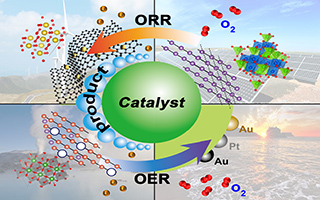

锂-空气电池正极催化剂表界面调控及构效关系研究进展
收稿日期: 2018-06-19
修回日期: 2018-07-10
网络出版日期: 2019-02-28
基金资助
北京市自然科学基金(No. 2182082)、国家自然科学基金(No. 11575192)、中科院重大仪器研制项目(No. ZDKYYQ20170001)、中科院CAS-DOE国际合作项目(No. 211211KYSB20170060)支持
Recent Developments in Surface/Interface Modulation and Structure-Performance Relationship of Cathode Catalysts for Li-Air Batteries
Received date: 2018-06-19
Revised date: 2018-07-10
Online published: 2019-02-28

高睿 , 王俊凯 , 胡中波 , 刘向峰 . 锂-空气电池正极催化剂表界面调控及构效关系研究进展[J]. 电化学, 2019 , 25(1) : 77 -88 . DOI: 10.13208/j.electrochem.180543
Lithium-air battery has been considered to be one of the most promising secondary battery systems because of its high energy density. However, the sluggish kinetics of the oxygen reduction reaction (ORR) and oxygen evolution reaction (OER) on the cathode, and the high overpotential, poor cycle stability and low rate capacity have severely blocked the development and application of Li-air battery. One of the effective strategies to alleviate these issues is to develop cathode catalysts for Li-air batteries. The design and development of bifunctional cathode catalysts with high activity and efficiency on both ORR and OER is highly desired for Li-air battery.The surface or interface structure has a significant impact on the catalytic performance. In this review, the recent progress in surface/interface modulation and structure-performance relationship of the cathode catalysts for Li-air batteries is summarized. The aspects of crystal plane effect, defect engineering, and surface-interface synergetic design have all been reviewed, which also include the recent results from the authors’ group. The new lithium-air battery system based on lithium superoxide with large rate capability and ultra-low overpotential is also presented. In the last, the key issues and future perspectives are also discussed. Although great progress has been made in the research of lithium-air batteries in recent years, the foundamental scientific issues such as catalytic mechanism and electrochemical reaction mechanism are still unclear. The solution of these problems is of great importance in the design and development of high-efficiency catalysts, and in the development of lithium-air batteries. Therefore, the applications of advanced characterization and analysis techniques should be emphasized in the future research, especially in situ electrochemical characterization technology to analyze the reaction mechanism at catalyst surface/interface, as well as the formation and decomposition process of the reaction products. Combined with the electrochemical performance analysis and theoretical calculation, the mechanism of catalyst action and electrochemical reaction will be revealed, which is of great significance to promote the development of lithium-air battery.

/
| 〈 |
|
〉 |